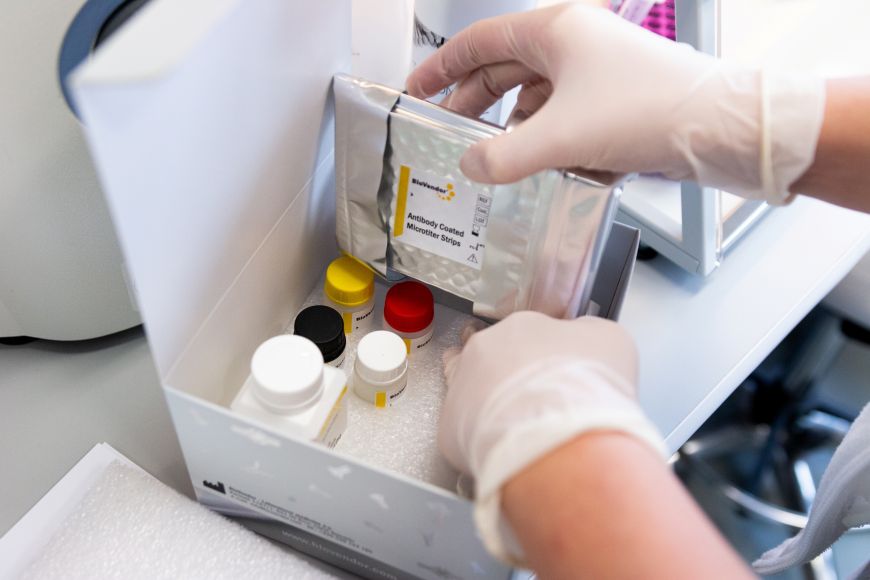Masaryk University, the Masaryk Memorial Cancer Institute and BioVendor, a private company (link in Czech), have signed a license agreement for a patented diagnostic set developed by the team led by Ondřej Slabý from CEITEC MU. The testing set could be available to doctors within two years.
The new diagnostic method enables early diagnosis and monitoring of colorectal carcinoma, or colon and rectal cancer, by simply testing the patients’ blood. This could be a game-changer for diagnosing and treating patients with this type of cancer.
Colorectal cancer is currently one of the most frequent types of cancer in the Czech Republic, which features regularly in the top positions of countries with the highest incidence of this cancer. About 8,000 new patients are diagnosed and almost 4,000 people die of colorectal cancer in the Czech Republic each year.
As a result, the Czech Republic has an extensive screening programme, where people over 50 years of age are regularly tested for colorectal cancer and precancerous conditions. In recent years, increased detection and treatment of precancerous conditions has led to a lower number of new colorectal cancer patients. However, Ondřej Slabý says that we are still failing at diagnosing more patients with the malignant carcinoma in an early stage and at improving the participation rate in the programme, which only captures about 30% of the target population.
One of the reasons why people are unwilling to take part in the faecal occult blood testing, which checks stool samples for hidden blood, is the general aversion to handling faeces. Moreover, the tumours that manifest in this way are often at an advanced stage. Another reason is that patients with positive test results undergo colonoscopy. This is an unpleasant test and often discovers nothing abnormal, which can be a further deterrent to future preventive tests.
“If we could detect the early stages of this disease from a blood test to allow timely diagnosis, we could help more patients since early-stage colorectal cancer is fully treatable,” says Slabý, adding that colonoscopy will always remain the key diagnostic method for this type of cancer. However, the blood test could mean that fewer patients have to undergo preventive colonoscopy.

These reasons initially motivated him to focus his research on finding such a solution, which he eventually did. The new diagnostic method is based on measuring the level of several circulating microRNAs, which get into the patient’s blood from the cancer tissue. The method is sensitive enough to detect whether the patient has a colorectal carcinoma, identify a relapse and predict the long-term survival chances of the patient – all from a small blood sample.
Tracking cancer
His search for less invasive methods to diagnose colorectal cancer led Ondřej Slabý, who was then a PhD student, to biomarkers. These are molecules whose presence in the body is characteristic of specific diseases and they can reflect both biological and clinical properties of the disease, such as prognosis and treatment response.
Slabý focused his research on short non-coding RNA molecules since the Human Genome Project showed that only a very small part of the genome contains protein-coding genes. The vast majority of the genome is transcribed into RNA molecules. These are non-coding, which means that they cannot create proteins, although they have many regulating functions that play a role in cancer cell biology. Researchers later discovered that certain types of these non-coding RNA molecules are used by cells to communicate with and influence other cells. MicroRNAs are a typical example of such molecules that cells are able to actively exude.
Significantly, carcinoma cells use the same method to communicate with each other. Far from being just a collection of cancer cells, tumours are complex tissues that contain various supporting types of cells including blood supply, and this is how their microRNAs enters the bloodstream. “This is what allows us to detect the presence and properties of a tumour in the patient’s blood,” says Slabý, summarising the significance of these molecules for diagnosis.
Taking advantage of the technology boom
The quest for the new diagnostic set was launched eight years ago thanks to a grant from the Ministry of Healthcare. “The technology advancement in sequencing nucleic acids and the resulting next-generation sequencing method gave us a huge boost. This method provided us with an easy way to find the microRNA molecules typical for colorectal carcinoma,” says Slabý. This is because the new technology allowed the researchers to read all the short RNA molecules present in the cancer tissue and bodily fluids, such as the blood serum.
To find the microRNAs that signal the presence of cancer and could indicate its properties, the researchers had to compare complete microRNA profiles in blood samples taken from both ill and healthy people, and this is where they used next-generation sequencing. They discovered several dozen promising molecules that were only present in patient samples. After further testing of blood samples from over 900 healthy and ill people, they selected four microRNAs to create a diagnostic score, which they had patented. This is a mathematical formula that reflects the combined levels of these molecules in the blood serum and the resulting value determines whether colorectal cancer is present.
As Slabý explains, “We then tested the diagnostic score on a blind sample set and were able to distinguish the patients from healthy people with a high degree of accuracy. We also verified that the scores decrease rapidly when the tumours are surgically removed and when patients undergo successful oncology treatment. In other words, it can be used to track the patient’s response to treatment and to monitor the patient for early detection of disease relapse.” He adds that the diagnostic score can also be used to predict three-year survival regardless of the clinical stage of the disease, which can be helpful for developing a personalised treatment plan.
Working with the industry
The researchers obtained a patent for their new diagnostic method and began working on its further development with BioVendor, a biotechnology company. In fact, it was actually the company who contacted the researchers. “We have a long-term interest in new biomarkers for diagnosis and treatment. About four years ago, we obtained a licence for a method that can detect microRNAs using a monoclonal antibody and we wanted to consult Professor Slabý about its use as he was one of the first in the Czech Republic to work with these molecules. He was just completing the diagnostic panel for colorectal carcinoma and we found that we had the same interests,” says Martina Hložánková, the director of research and development at BioVendor, about the start of the collaboration.
First, the company conducted its own study to verify that the diagnostic method worked and that there was potential for its future development. “We adopted this approach because historically we were only able to replicate the study results in about 10% of the biomarkers that we licensed,” explains Hložánková. After a period of close collaboration with the researchers on further development, the company signed a licence agreement for the patented diagnostic set at the turn of the year. The MU Technology Transfer Office helped negotiate the terms of the license agreement.
“In addition to the one-time license fee, BioVendor will also pay the patent fees and once the product is launched, we will be entitled to a share of the sales revenue,” says Jana Daňková, a project manager at the Office, about the agreement.
However, it is not all set and done yet. Further fine-tuning of various systems and the setup of the diagnostic tool is needed before it can be used with patients while developing the production technological process alone will take about six months. The final step is a clinical validation planned to be conducted on a group of patients with hereditary forms of colorectal carcinoma, which constitute around 15% of all colorectal cancer.
Slabý believes that the new diagnostic tool will be available to doctors treating patients with colorectal cancer within two years. Both Slabý and the company hope that they will be able to develop another version of the test that could be used for screening, which would help further increase the number of patients diagnosed in the early stages of the cancer.
